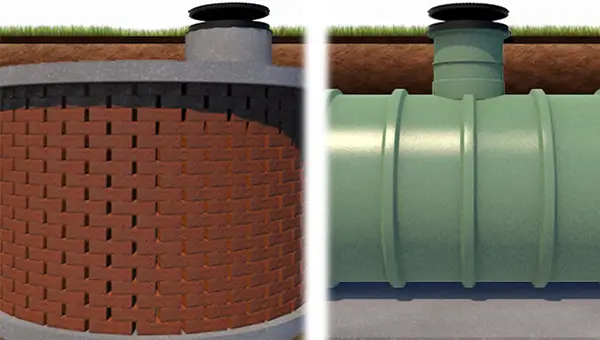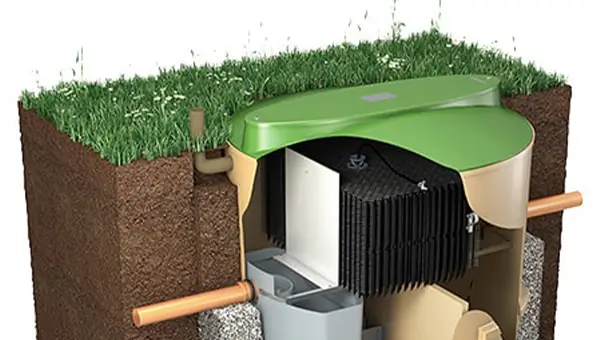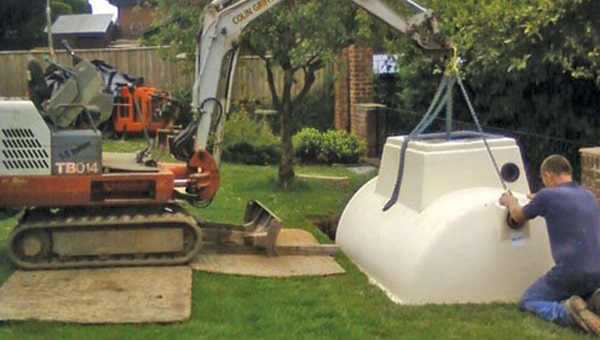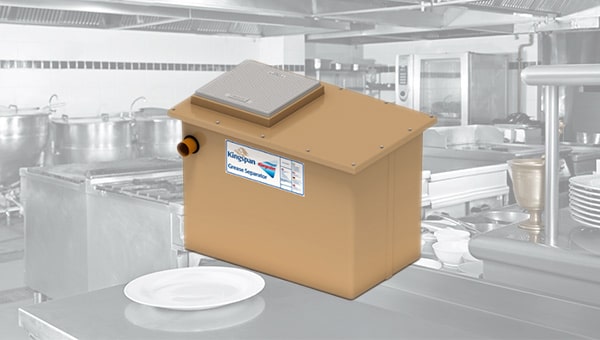The topic of off-mains drainage can be a confusing one, and sometimes it can be difficult to find the answers to your questions all in one place. We've put together this handy FAQ article to hopefully answer all the septic tank questions that you come across in your journey to off-mains drainage enlightenment.
General Septic Tank FAQs
What is a septic tank?
A septic tank is essentially a large container that is installed underground and designed to store and partially treat domestic sewage and wastewater.
Usually made of either concrete, Glass Reinforced Plastic (GRP) or High Density Polyethylene (HDPE), septic tanks are the most common drainage solution for properties that can't connect to the mains sewage system.
How does a septic tank work?
Septic tanks, whether they are single or multi-chambered, utilise the simple process of gravity to separate the liquid waste from the solid waste that flows into it from your property.
The lighter solids in the waste, along with oil and grease, float to the surface and form a "scum" layer. The heavy solids sink to the bottom of the tank, where they are partially broken digested by anaerobic bacteria that develops in the tank, and form a “sludge” layer. The remaining liquids left suspended between these two layers, flows out of the tank (sometimes via a second settlement chamber) into a septic soakaway/drainage field. The discharged effluent is then dispersed into the surrounding soil, allowing naturally occurring aerobic (waste-degrading) bacteria to break down any remaining waste.
Who needs a septic tank?
Septic tanks are required for properties that cannot be connected to the mains public sewer system and also can’t be serviced by a sewage treatment plant that discharges into a suitable watercourse.
What is the difference between a septic tank and a sewage treatment plant?
Both systems use gravity to separate liquid waste from solid waste, however a septic tank doesn't treat effluent and can't discharge into a watercourse whereas a sewage treatment plant produces near-clean effluent.
A sewage treatment plant adds an important extra stage in the process. After the solids have been separated, the wastewater is subjected to the introduction of oxygen into the system via an air pump, which encourages the growth of aerobic bacteria. The bacteria then works to break down the remaining sewage into a cleaner effluent within the tank. This extra treatment stage makes the effluent discharge substantially cleaner and less harmful to the environment, enabling a sewage treatment plant to discharge directly into a watercourse (subject to compliance with the General Binding Rules). For a more detailed comparison of these two systems, read through our do I need a septic tank or sewage treatment plant guidance.
What is the difference between a septic tank and a cesspool?
Cesspools are primarily a storage tank for effluent, and unlike a septic tank, do not treat effluent in any way. They require emptying at regular intervals to prevent overflowing.
Where a sewage treatment plant can be considered as an evolution of the septic tank, a cesspool can be seen as being what the septic tank evolved from. With a cesspool, there is no discharge point, there is no treatment of sewage contained within. It is simply a storage tank that holds the waste from your property and needs emptying on a much regular basis. They should only be considered when all other off-mains drainage options have been ruled out. Check out our guide to off-mains drainage for more information.
What is the difference between types of septic tank?
All septic tanks process and discharge sewage and wastewater, and come in all shapes, sizes and materials, and often the differences relate to how they are installed.
Concrete tanks are substantially heavier than HDPE or GRP ones, and so require more heavy duty lifting equipment. GRP tanks are lightweight (in comparison) but are more prone to being damaged during transport and installation. Spherical (or Onion) shaped tanks take up less space beneath your garden, but require a deeper hole. Shallow dig/low profile tanks require less depth, but take up more horizontal space. Often, the type of septic tank you need will be influenced more by legislation and site requirements than by your personal preference. Check out our “Septic Tank Installation Guide” for more information on this.
How much does a septic tank cost?
In general, for most domestic systems, the cost of a septic tank will be somewhere between £500 and £2000.
It largely depends on the size of tank you need. A 2800 litre (5 person) spherical tank from Clearwater would cost you in the region of £500 to £600, however, a 79,000 litre (513 person) tank from Klargester costs over £12,000 (at the time this article was written).
What is the delivery time for a septic tank?
This can vary depending on size and manufacturer, but most of our septic tanks can be delivered within 5-7 working days.
Which type of septic tank is best?
The best septic tank depends on your site conditions and usage.
It is extremely difficult to give advice on what type of septic tank will be best for you without first knowing the details of your property and install conditions. However, in the design the system section of our septic tank installation guide, we have put together a table of factors that are worth considering when making your choice.
How many years does a septic tank last?
The lifespan of a septic tank can depend on many factors including ground conditions and how well it is maintained. Typical lifespan is in excess of 30 years for GRP, PE and concrete tanks.
Assuming optimal conditions of install and use, you could expect the following:
- Steel septic tanks have a life expectancy of 15 to 20 years. These should not be used for new installations but can still sometimes be found in older rural properties.
- Plastic (PE) or fiberglass tanks (GRP) have a life expectancy of 20 to 30 years.
- Concrete tanks have a life expectancy of 30 to 40 years (sometimes longer, depending on conditions).
Are septic tanks bad for the environment?
With accurate sizing, proper installation and regular maintenance of both septic tank and drainage field a septic tank system is no more harmful to the environment than any other waste management solution.
if the system has not been properly designed, installed or maintained it can lead to contamination of surface and ground water resources that will be damaging to the environment and potentially hazardous to public health. Having your system designed and installed by qualified professionals, and making sure that you follow all use and maintenance recommendations given by the tanks supplier, is the best way to ensure that your septic tank is environmentally safe.
Do all septic tanks need a soakaway/drainage field?
All septic tanks need a soakaway or drainage field to treat the effluent stored within the tank.
Septic tanks do not work in isolation; the effluent produced is not treated within the tank to a point of being safe for discharge. Treatment comes from the drainage field or septic soakaway (surface water soakaways, soakaway pits, soakaway crates or tunnels must NEVER be used for the discharge of septic tank effluent).
As of January 2020 septic tanks are no longer allowed to discharge directly into a watercourse. This means that for all new septic tank installations, a drainage field is your only discharge option and must be installed along with your tank.
What if there is no space on the property for a drainage field?
If you can't install a drainage field for your septic tank to discharge into you can't install a septic tank, and you must either pump sewage and wastewater to the nearest mains sewer or use a sewage treatment plant.
A sewage treatment plant produces clean enough effluent to allow for discharge to a watercourse. Failing connection to the mains sewer or a sewage treatment plant you would need to look at installing a cesspool instead, as storing your waste for regular removal by a registered carrier would then be your only option.
Who is responsible for a septic tank system?
In terms of both the physical operation and maintenance of a septic tank system, and legal accountability should it fail and pollute the environment, the operator of the system is the one responsible.
According to the UK government, you are deemed to be the operator if any of the following is true:
- you own the property that uses the system
- you own a property that shares the system with other properties - each property owner is an operator and you’re jointly responsible for complying with the general binding rules
- you have a written agreement with the property owner that says you’re responsible for the system’s maintenance (for example you’re renting and it’s in your tenancy agreement)
If still unsure, you should contact your national environment agency to find out if you are an operator.
What are my responsibilities when selling a house with a septic tank?
It is a legal requirement of the operator to inform the buyer in writing about off-main sewage systems for the property and to provide a detailed description of its use, location, required maintenance and up to 7 years worth of maintenance history.
When selling a house with a septic tank, the most important thing is to be transparent about it’s age and condition, and to give the buyer as much information as possible. If your septic tank is nearing the end of its life span, the buyer will need to know this, and you may need to consider renegotiating the selling price to account for the system being replaced or to have the work carried out yourself before selling. You wouldn’t like to be tricked into buying a house with a septic tank system that fails a year later, so don’t be tempted to try and trick someone else into buying yours just to save money.
What should I check if I’m buying a property served by a septic tank?
When buying an house with an off-mains system it is important to understand that you will be taking on full responsibility for said system and so should endeavour to find out as much as possible about it.
Ask the current property owners questions such as:
- How old is the system and when was the tank and drainage field installed?
- Has the tank been regularly emptied?
- How much does it typically cost to empty?
- Is the system shared with any other properties?
- What condition are the tank and the pipework in?
- Has there been any problems with the system?
They should be able to answer most of these questions very easily, so be wary if they seem unsure. However, because the system is all underground, it can be difficult to ascertain the condition of the tank and pipework. This is something you are likely going to have to insist on being properly inspected. It is vital to ensure you aren’t buying a property with a sewage system on the brink of failing, but a standard building survey won’t cover it. For this you will need to have a Homebuyer Drainage Survey carried out by a suitably qualified inspector.
This in-depth report will tell you all you need to know about the health of the system and whether there are any issues that should be addressed to ensure trouble-free use after your purchase of the property. Knowing if there is any repair work that needs to be done, or if the system needs replacing entirely, will give you good ground to negotiate the selling price and/or back out if the seller is unwilling to budge.
What are the new rules & regulations for septic tanks?
Legislation for England prevents septic tanks from discharging into watercourses from 1st January 2020, and require operators to update their system with a drainage field, sewage treatment plant, or other off-mains drainage solution.
This must happen either when a property is sold or as soon as possible. All new septic tanks must be installed with a drainage field to comply. Find out more about how the new rules and regulations affect septic tanks.
Installation Questions for Septic Tanks
Do you need a licence or permit for a septic tank?
In certain circumstances a licence or permit is required for a septic tank.
- If you discharge more than 2 cubic metres (2000 litres) per day
- If you discharge in a groundwater source protection zone (SPZ1)
- If your discharge will be within 50 metres of any designated sensitive areas
Check with your national environment authority for further details.
Do you need to register a septic tank with the environment authority?
In England, you aren't required to register a septic tank with the Environment Agency, but may need a permit in certain circumstances. In Wales and Scotland septic tanks need to be registered with the environment authority.
What size septic tank do I need?
The size of your septic tank should relate to the number of people it will service.
Septic tanks are usually categorised firstly by their capacity and then by the number of people they can service, so you need to be able to determine the minimum population size of your property as well as the volume of sewage and wastewater that your property is likely to produce. For these reasons, we would recommend reading our dedicated how to size a septic tank or sewage treatment plant guide to ensure you are selecting the right capacity for your property.
What size drainage field do I need?
Drainage field size depends on the size of your property, number of occupants, and the results of percolations tests to determine soil condition.
It's a tricky calculation to get right, but our guide to sizing a drainage field can help get you started.
Do I need planning permission to install a septic tank?
You must have both planning permission and building regulations approval to install a new septic tank.
If your system did not receive permission and approval before being installed, you must apply for it retrospectively, or contact your local council for advice if it was installed prior to 01/01/2015.
How long does a septic tank installation take?
Installation of a septc tank typically takes 1 to 2 weeks.
This will depend largely on the size of the system required, the conditions of your installation site and even the weather.
How do I install a septic tank?
Installation of a septic tank should be carried out by drainage contractors and professionals, it is not recommended to install one yourself.
Alongside all of the legal steps to take before installing a septic tank, most issues and problems occur due to incorrect or faulty installation. If you've got the skills though, read through our how to install a septic tank guide.
Using a Septic Tank FAQs
What's the best toilet paper for septic tank systems?
Toilet paper labeled as "biodegradable" require less water to break down, and will dissolve at a much faster rate than regular toilet paper, and is less likely to cause a blockage in the system.
Can I use bleach if I have a septic tank?
Normal household bleach, if used in moderation, should be fine for use with septic tank drainage systems, but try to avoid any extra strong bleach products as these could negatively affect the bacteria in the tank that works to break down the solids.
What cleaning products can I use with a septic tank?
Most multipurpose household cleaning products and laundry detergents are fine for use in moderation, but ideally you will want to go for ones that are mild and phosphate free if possible.
The problem with septic tanks and cleaning products is that too many chemicals entering the system can disrupt the bacteria balance and eventually lead to major problems such as the tank clogging up and harmful waste leaching into the groundwater. You can help your system avoid these problems by looking for cleaning products that specifically state they are safe for septic tanks and/or choose products labeled as eco-friendly, as these contain less harsh chemicals by design. The main thing though is to just avoid any high strength chemicals, use all cleaning products in moderation and do not use things like liquid drain cleaners on a regular basis, as those types of chemicals are extremely caustic.
What can/can’t I flush into a septic tank?
Do not dispose of cat litter, sanitary products, nappies, cigarette butts, anything plastic or non-biodegradable, such as ear plugs and dental floss if you have a septic tank. Avoid disposing of flushable wipes, face wipes, cosmetics, fats or cooking oil, antibacterial handwash and cleaners, food scraps and coffee grinds.
Keep these items to the rubbish bin and not the toilet or drains!
Emptying your Septic Tank FAQs
How often do you need to empty/desludge a septic tank?
Septic tanks are typically emptied once every 12 months, but can be more frequent depending on tank size, operation and usage.
It is imperative that you do have it desludged and serviced by a registered carrier as regularly as the manufacturer advises to ensure that the septic tank continues to work properly.
Whose responsibility is it to empty a septic tank?
It is the responsibility of the person deemed to be the operator of the system to have the septic tank regularly emptied.
How do you know when your septic tank is full?
If you start to see toilets flushing more slowly or overflowing, or dirty water pooling above the septic tank or drainage field, the septic tank is either full or there is a blockage somewhere in the system.
Listen to the advice given to you by your desludging or servicing engineer. They'll tell you if the tank seems to be filling up more quickly than expected or if they start to see issues starting to arise.
What happens if you never pump your septic tank?
If you don’t have your septic tank pumped or emptied on a regular basis the solid material that doesn’t get discharged through the drainage field will continue to build up, the tank will start to overflow, and sewage and wastewater will start to back up into the property.
If left un-pumped the drainage field and/or the septic tank may need to be replaced.
Who can pump/desludge my septic tank?
It is a legal requirement to ensure that you only have your septic tank emptied by a registered waste carrier. Do not be attempt to empty it yourself.
As the person responsible for the system and its maintenance it is recommended that you ask the company you use to confirm their registered status and ask to see a copy of their waste certificate. If the company was found to be dumping the waste from your tank illegally pleading ignorance of them not being a registered carrier would not do you any favours.
Should both chambers of a septic tank be pumped?
If your septic tank has multiple chambers both should be pumped and emptied according to the manufacturer servicing schedule, or as often as your tank size and usage requires.
This is because, while it is the inlet side that will see the largest build up of sludge, the outlet side in a multi-chamber tank acts as a second settlement stage that will still see some solid material build up over time. While it isn’t always necessary to have the outlet side pumped, the waste carrier is there anyway, so why not get them to do it and keep your tank operating at optimal levels for as long as possible.
How do I maintain my septic tank?
It is recommended that you have a service agreement for your tank and set up an annual desludging contract with a registered carrier. Both of these are critical to the longevity of your system. It is also a requirement of the new PPG4 guidelines.
Aside from this, there are other things that you can do yourself to help prolong the life of your septic tank and soakaway drainage field. These include:
- Don't use your toilet and sink as a rubbish bin
- Be sensible with the cleaning and disinfection products you use
- Divert rainwater from the drainage field
- Don't overload the drainage field or drive vehicles over it
- Keep trees and foliage away from the drainage field
- Be vigilant against signs of problems with the system
Read our septic tank installation guide for tips on how best to maintain your septic tank system.
Why do septic tanks fail?
A change in ground conditions, a faulty baffle or dip pipe, tree or plant root damage and the age of the system are leading faults of septic tanks.
- The ground around your property may become more saturated, the water level could rise or fall and the ground around your tank can shift. All of these things can put extra pressure on your system (sometimes literally) and cause it to fail. Tanks can crack and drainage fields can become waterlogged, resulting in them needing to be replaced.
- Depending on the type of tank you have, a faulty baffle or dip pipe exist to ensure that only the liquid effluent can pass through to the drainage field. If they are faulty or get damaged during routine emptying, the solid material will be able to enter the drainage field and clog it up.
- Tree and plant roots can grow through the walls of the tank and pipes in the drainage field causing major damage. Keep landscaping away from septic tank and drainage field.
- Tanks that are coming to the end of their design life span may need replacing.
A properly installed, serviced and maintained septic tank system should operate problem free for many years.
Why does my septic tank have a scum on top?
The layer of scum floating at the top of a septic tank forms naturally as part of the separation process. It’s made up of substances that are lighter than water, such as fats, oils and grease, and acts as an internal lid over the effluent below.
Should my septic tank smell?
A properly maintained septic tank should never smell! If you notice a bad drain smell in your house or out near the drainage field, this is a sign that there is a problem with the system and you should have it checked out by a professional.
If you've reached this far you can now claim septic tanks as your specialist subject in your next quiz. But, should you have any further questions, or need any advice on how to install, operate or maintain a septic tank system, contact us today — our technical team is always on hand to help with all of your drainage needs.






